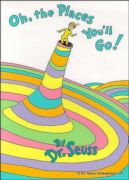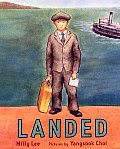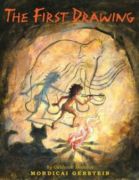
One book . . .
Two readers . . .
Two perspectives . . .
Your Take?
A Thematic Dialogue on Selected Books

Oh the Places You’ll Go by Dr. Seuss, New York; Random House, 1990.
Angie Hoffman
I had a delightful experience today. I reread Dr. Seuss classic, Oh the Places You’ll Go. The copyright indicated that this book came out in 1990. As I read each page, everything came back. There was a boy dressed all in yellow (even wearing a yellow knitted hat); trees that looked like large pink flowers with large stems; a field with different roads; a boy flying in the sky in an air balloon; people waiting in line for a bus, plane, or the mail; bright places where Boom Bands are playing; where elephants have banners flip-flapping through the Hakken-Kraks howl; many strange birds, and a move to the mountains. Every one of Dr. Seuss’s illustrations sprang from the page, long forgotten and then, suddenly, vividly remembered. He got his ideas from the same place most good authors get theirs; from within, and most probably from fishing the deepest wellsprings of his childhood.
Dr. Seuss books falls into two categories; the “big” books being several inches wider and taller than his Beginner Books. Most of his books have “messages” of moral or ethical import embedded in the funny stories. This book was his last boo and was full of his art and philosophies and in some ways his personal life that we know had its ups and down. Through determination, though, he did succeed. What really attracted me to this book was his ability to provide so much knowledge in a simple story.
What is more essential in a Dr. Seuss book, the words or the illustrations? Millions of us, of all ages, have these memories in common. Dr. Seuss’s rhymes and wacky wordplay were our first experience of metrical verse, verbal gymnastics, and unbridled literary imagination. And we rediscover all these unique qualities when we introduce his books to our own kids. The illustrations fashioned on paper, as Maurice Sendak wrote in his introduction to the Secret Art of Dr. Seuss, “The slippery, sloppery, curvy, altogether delicious Art Deco palazzos invite you to slide and bump along, in and out of laming colored mazes… Ah! …playing with a sensuous, loony physicality that re-creates the gleaming, rapturous infant domain, where various openings are to be seriously investigated and explored. All this tricked out with enormous technical panache: Seuss the Craftsman working hard to make your forget Seuss the craftsman.” The illustrations make the words come alive.
This is my take, Dr. Seuss was a part of my life from my earliest years because of his play with words and his unique illustrations. As time passed, the reality of a roadmap for life is present also. Amazing…
Monique Storie
The story is a classic children’s book that provides encouragement and advice for taking on an adventure. The work is uniquely Suess in its light, simple, yet encouraging text and its Suess-esque illustrations. It begins with the protagonist, an unnamed character that the author refers to as “You”, being congratulated for the journey he is about to begin. Over the first few pages, Dr. Suess tells the protagonist that he is prepared and in control of the adventure and where it takes him. Suess then reminds that every adventure will have its ups and downs, its excitement and its lulls, its challenges and obstacles. Suess takes time to emphasize that these are a normal part of any journey. The book ends with the reminder that just as “You” was prepared to begin his journey, he is just as prepared to deal with the problems that he might encounter during his adventure and that his success is 98 and ¾ percent guaranteed so he had better get his adventure started.
In rereading this book, two wonderful details stand out for me. First, I loved the sense of agency that the book gives to the reader at the very beginning such as when the narrator points out that the adventure of a lifetime is at the protagonist’s fingertips should he choose to take it and that the direction it takes is also entirely within the main character’s control: “You’ll look up and down streets, … / About some you will say, ‘I don’t choose to go there.’ / With your head full of brains and your shoes full of feet, you’re too smart to go down any not-so-good street.” This sense of agency carries all the way until the end so that when the narrator says “… you’re off to Great Places! / Today is your day!/ … So … get on your way! the reader can almost feel that the narrator is saying “well, what are you waiting for?!?”
The second detail I greatly appreciated was the author’s pointing out that any adventure has its obstacles. The phrases “You can get so confused / that you’ll start in to race / down long wiggled roads at a break-necking pace / and grind on for miles across weirdish wild space, / headed, I fear, towards a most useless place. / The Waiting Place” frankly points out that sometimes, we will idealize what we expect to happen, so that when life doesn’t happen the way we envisioned it in our heads, we can become paralyzed in thought/indecision or we don’t know how to continue on. This detail helps to remind us that any journey or adventure will require resiliency and some persistence.
Because it is considered a classic and has a strong message about taking an adventure , I wonder what books might it be paired with to bring out the idea of having the courage to do something new.

Landed by Milly Lee, Illustrated by Yangsook Choi. Frances Foster Books, 2006.
This historical fiction, based on a true story of the author’s father-in-law, tells the story of Chinese immigration to the United States through Angel Island in the early 1900s.
The Plot
Shortly after his twelfth birthday, Lee Sun Char is told he will be moving to America to work at their family’s business. He is excited to be reunited with his brothers, especially Ming, who took a single prized possession, a Chinese compass, with him when he left two years earlier. Before leaving, Sun must study with Mr. Chan who helps Sun to learn all the details about his home life in China so that he will be able to answer any question the immigration officials might ask him because one wrong answer can send him home. Sun studies diligently with Mr. Chan, who has Sun draw maps and charts to help him remember details; and then, later, with his father while they are aboard the SS President Taft, the ship that brings them to Angel Island. He hopes that he is able to answer his questions correctly, worries that they don’t ask him about directions, something that he still hadn’t mastered. The night before their arrival in San Francisco, Sun’s father explains that because this is Sun’s first entry into the United States that the officials will separate them and take Sun to Angel Island to be interviewed and questioned and they say their goodbyes.
At Angel Island, Sun is subjected to a physical examination that embarrasses him before being admitted to the men’s barracks. There, Sun is befriended by Hop Jeong, who has been waiting for his interview for five weeks, and Puy Gong, whose denied entry is being appealed by his family. Through them, Sun learns about paper sons, or Chinese boys who are presented as the children of U.S. citizens or Chinese merchants in order to gain entrance into the country, how to survive in the center, and what the interview process would look like. Sun confides in them he still worries about them asking him about directions. In time, Hop is passes his interview after three days of questioning and will be landed, or allowed to enter San Francisco. When they say their goodbyes, Sun asks Hop to let his father know he is fine. When Sun is called for his interview, he is asked so many questions about the details of his house, making him grateful for Mr. Chan’s lessons. To his dismay, the two officials then ask him about directions, such as which way his bedroom faced and his neighbor’s house faced. No matter how hard Sun tries, he is unable to figure it out. After two days of being unable to answer the officials’ questions about directions and wishing his brother was there to help him, Sun receives a box of cookies and a secret surprise, Ming’s compass, which Sun promptly places into the secret pocket his mom had sewn into his clothes. When he is asked about directions in the final day of his interview, Sun paints a mental picture of his village, pulls out the compass, and then confidently answers the question. Just when all seemed well, Sun’s chance at a new life in the United States becomes at risk when one of the interviewers questions whether or not Sun cheated by using the compass.
My Take:
I had at one time wondered what the Pacific counterpart to Ellis Island was; I figured there had to have been something similar but had never found any references to one. So, when I happened upon this book while looking for immigration stories, I was instantly intrigued and excited to read about it and see how it fit into the concept of New Beginnings.
In terms of the theme, Landed is a good story to highlight the process of preparing one’s self for a journey (whether it is a physical journey or a mental challenge). I was completely drawn in by the ways Mr. Chan encouraged Sun to learn about his life, such as by drawing maps and charts of his home, village, and family structures. Even though my heart ached for the 12 year old who would be abandoned until the immigration officials were convinced that he was a “true son,” I appreciated the part of the story when Sun’s dad told him how they would have to be separated when they first arrived in San Francisco and what Sun would need to do by himself before they could be reunited. Interestingly, in some ways, Landed illustrates what Dr. Seuss means in Oh the Places You Will Go:
… You’re off to great places. You’re off and away! You have brains in your head. You have feet in your shoes. You can steer yourself any direction you choose. You’re on your own and you know what you know. And you are the guy who will decide where to go. … You’ll look up and down streets. Look ‘em over with care. About some you will say, “I don’t choose to go there.” With your head full of brains and your shoes full of feet, you’re too smart to go down any not-so-good street (Suess, unpaged).
The story helps to demonstrate that in any journey there will be hard parts to endure or overcome, but that relying on yourself and what you know will give you the confidence and tools you need to complete your journey.
Stylistically, I found the book to be a complex (almost confusing) reading experience. On the one hand, I loved how the author and illustrator used Sun’s process of studying as a way to insert details about the way their family lived in China into the story, building up a rich sense of reality. Similarly, the conversations with the “paper sons” at Angel Island were great ways to convey historical details in a very seamless way. As I read the story, my mind was bombarded with questions, such as “What is a Chinese compass… and does it look any different?”, “Is Angel Island real?” and “Was the SS President Taft a real ship?” I can imagine many boys and budding history buffs asking similar questions.
Conversely, I was anticipating more drama in the text; but it didn’t materialize, leaving me grappling to make sense of my connection to the story. Even when the plot thickened or when Sun was expressing anxiety about his interview, I felt a tone of serenity in the author’s words and presentation. I was confused as to why the story did not contain more tension (I recall asking myself “Doesn’t the plot require more tension, more action, more umph!?”); and I worried that the author may have played it safe in her characterization or was using a stereotypical image of a Chinese boy (“Is Sun too quiet, reserved… I mean, as a twelve year old, I’d be terrified to be separated from my parent in a country where I didn’t know the language or the laws.”… I later decided that a twelve year old then is much more mature than a twelve year old now).
BUT, even amidst my anxieties, I found the story worked. I understood Sun. I was saddened by his being separated from his parents; first, when he left his mother in China, and then later when his father had to disembark the SS President Taft without him. I felt his shame in having to take his clothes off for his Physical Examination. I understood how camaraderie helped him to endure his time in Angel Island. Finally, I rooted for him during his examination (to the point where I was talking to the book, defending Sun against the immigration official). In the end, I felt the journey I had taken with Sun was well worth it.

The First Drawing by Mordicai Gerstein. (New York: Little, Brown & Co, 2013)
The First Drawing is a picturebook that hypothesizes how the first drawings (drawn over 30,000 years ago) came to be. I have to admit that I was initially unsure about this book. The First Drawing seemed to have such a serious tone that I wondered if it would appeal to kids at all. However, after a few readings, I have come to appreciate the story for its ability to make older readers think about how an innovation can change the future and past innovations have dictated what we consider normal today.
In my first reading, I was thrown off by the narrative style. The narrator speaks directly to the reader; making it seem like the story was begging to be read aloud. However, the opening pages seemed so matter-of-fact that when the main character begins to imagine and speak, his voice felt out of sync, making it difficult for me to find the right voice to read it in:
You live in a cave with your parents,
Grandparents, sisters, brothers, uncles,
Aunts, many cousins, and your wolf, Shadow.
It’s a big cave.
You love to watch animas.
You see them everywhere.
….
You see the grand white and gray clouds
that drift over the valley.
Their ever-changing shapes look to you like a parade of animals.
“Papa! That cloud looks like a woolly mammoth” [p.3-6]
It took a few pages of the switching between the narrator speaking directly to the reader and the boy speaking to his family before I was able to settle into the narrative style and feel comfortable in the story.
However, when looking at the book through the theme of new beginnings, I can appreciate the story for its ability to point out that every everyday items we use—whether it be a pencil, ink, a drawing, a phone, a computer, or a tablet— had a beginning. This is something I have thought about many times over the years but Gerstein’s presentation does a wonderful job in capturing that thought in a story about an action we do so thoughtlessly in today’s world. I liked the boy’s ability to stay upbeat when his family could not see what he saw. Even when the family downplayed the boy’s imagination “They call [him] ‘Child Who Sees What Isn’t There’” [p.9], he kept asking himself “how can I make them see?” For me, his tenacity reminds that not everyone will get a new idea at first but you have to keep trying and trying to get others to see your point of view. The dialogue between the boy and his various family members (I especially liked the father’s response to the boy saying he saw a woolly mammoth “Child! Child! Your father sighs, “What are we going to do with you?”) as well as the illustration of the entire family in the cave (you can see the angry, frustrated, and bewildered faces of his relatives as the boy tries to verbalize what he sees on the cave walls) drives home the point that any innovation will have its doubters before it has believers. By the end of the book, the boy has created the first drawing and set the stage for generations of drawings.
The First Drawing is definitely a book that would work well in a text set about innovations and inventions and the storyline can niggle at the back of your brain long after the story is done. While I wonder how long the book would hold the attention of younger readers, I can see it being a great discussion book for older elementary readers to get them talking about famous/unknown inventors as well as the role of innovation in history.
